Matt Letourneau
“Listen carefully, my son, to the master’s instructions, and attend to them with the ear of your heart,” the first line of St Benedict’s Rule commands. Listening can be virtuous, but how can you hear God’s soft melody over modern life’s constant clamour? For Cistercian monks, the answer is straightforward: build a colossal church in the middle of nowhere. Although this may seem like an oversimplified solution, these monasteries provide a sense of seclusion and tranquillity, where monks can devote all their energy to seeking God. However, even though solitude in a monastery is important to monastic life, a monk undertakes many more initiatives than isolation and silence to ‘hear’ the Lord.
When I joined the order in 1997, there were 150 monks in Ireland. There were 50 monks here. But over the last 25 years, a lot of the guys have died. Fewer guys have joined. 27 years later, I’m still the youngest monk”
When I came to Ireland from the US a couple of months ago, I didn’t know of this country’s extant monasteries or the countless ruins of abbeys lying dormant in the countryside. I knew the caricature of a monk, wearing a brown habit and tonsure, but I had no clue what real, modern Benedictine monks were like — their lifestyle, culture and spiritual beliefs. Therefore, when I learned of their presence around the country, I realised I had to investigate how the monks’ religious practices differed from everyday spirituality.
My ignorance may have been justified, as their community has suffered a steep decline, dwindling in both number and influence. From the 12th to 16th centuries, there were 550 separate monasteries and abbeys in Ireland. Today, there are only five. Furthermore, as Fr Richard Purcell, former abbot and current prior of the Cistercian community at Mt Melleray Abbey, explained, “When I joined the order in 1997, there were 150 monks in Ireland. There were 50 monks here. […] But over the last 25 years, a lot of the guys have died. Fewer guys have joined. 27 years later, I’m still the youngest monk.” Today, only seven monks reside at Mount Melleray, and only around 30 Cistercian monks live in Ireland
However, this is not wholly an affliction for the Cistercian Order, as decline can also be viewed as a natural stage in monastic history. A decline in monks may also bring original monastic values back to the forefront of the community. Therefore, I decided to adventure to Cappoquin, Co. Waterford and visit Mount Melleray Abbey to explore monastic culture and discover how the Irish Cistercian Order stays devoted while losing its monks.
History
To know how Irish Cistercian monks serve God amid this current ‘monastic recession,’ one must first understand the basic history and beliefs of the Irish Cistercian Order. According to Fr Richard, “Monastic life was always for people who wanted to step away from their life.” Christian monasticism began in Egypt in about 270 AD. It was pioneered by the hermit St Anthony, who spent his life in solitude in the Nitrian Desert, focusing all his attention on God. In the sixth century, the Catholic St Benedict expanded this concept. With his experiences in solitude and living with other monks, St Benedict founded 12 monasteries and wrote St Benedict’s Rule, a 73-chapter book that outlines the rules of monastic life. Since then, Benedictine monks have used St Benedict’s Rule to dictate their lives, from how they sleep to how they eat.
After a few prosperous centuries, Cistercian monasteries were suppressed under King Henry VIII during the reformation in 1539, leaving abbeys in ruin”
Centuries after St Benedict passed away, the Cistercian Order was born, and it spread across Europe rapidly. In 1098, Benedictine monks from the Molesme Abbey, France lived under a relaxed observance of The Rule. However, they wanted to live by the strictest possible interpretation, so they moved to the remote marshlands of Cîteaux and founded the first Cistercian community. In 1142, St Malachy, the Archbishop of Armagh, requested for monasteries to be built in Ireland, so a group of monks founded the first Cistercian monastery in Mellifont.
After a few prosperous centuries, Cistercian monasteries were suppressed under King Henry VIII during the reformation in 1539, leaving abbeys in ruin. However, after Catholic Emancipation in 1829, Fr Vincent Ryan (Dom Vincent), the first abbot of Mt Melleray, laid his eyes on Scrahan, a barren area in the Knockmealdown Mountains, known by locals as ‘the coarse land’. With 200 monks seeking to escape France before the French Revolution of 1830, Fr Ryan brought 64 Irish and English monks from France to Scrahan. Together, they founded the first post-Reformation monastery in Ireland: Mt Melleray Abbey.
However, the hardships of these monk refugees don’t stop there. Just like the Nitrian Desert and Cîteaux, the Scrahan was a squalid wasteland, littered with stones on infertile soil. Therefore, the monks took on the task of reclaiming the land. They tore up thousands of rocks, loosened and dug into the soil with spades, ploughed manure over 470 acres of land and planted 17,000 trees. Many villagers and religious communities from the surrounding area came to help with this monumental task, walking dozens of miles every day to assist at the site. Using the stones they dug up, they constructed a church, opening in 1838 for services. Then, on the abbey’s centenary, the ‘new abbey church’ started construction in 1933, finishing in 1940. Since then, the abbey has added a guesthouse, accommodations for the monks, a boarding school, a dairy farm, a cemetery, a museum, a cafe and many other amenities.
Mount Melleray
As the bus weaved deeper into Co. Waterford’s green countryside, through quaint villages and past beautiful farmland, I found myself in the small town of Cappoquin. The old church and main street were enveloped in silence, with only a few cars on the road, an occasional pedestrian walking by and the wind rustling nearby leaves. Eventually, the sound of a car broke the town’s quiet, and a man in a black and white habit, Fr Richard, sat in the driver’s seat. I hopped in, and we embarked up the mountain until we arrived at Mt Melleray.
St Benedict’s Rule states, “All guests who present themselves are to be welcomed as Christ, for he himself will say: I was a stranger and you welcomed me”
As I stood at the base of the Church, its immense stone tower and nave, blackened by centuries of weather, watched over the farmland and village beneath it like a benevolent guardian. “There is so much happening in the outside world. It’s busy, busy, busy,” Lizzie Connor, a guest who has frequented the abbey for the past 15 years, told me, “This is the place you can rest awhile. There’s nothing but stillness. It’s a piece of heaven.” Walking through the garden towards the guesthouse, I heard nothing but birds chirping, a fountain’s gentle splashing and the grass crunching quietly beneath my shoes. I saw resting cows, chewing fresh pasture, and I inhaled the crisp morning air. All I felt was tranquillity.
St Benedict’s Rule states, “All guests who present themselves are to be welcomed as Christ, for he himself will say: I was a stranger and you welcomed me (Matthew 25:35).” Hospitality is an important part of monastic life, and Mt Melleray has a dedicated staff and guesthouse for meeting the demands of visitors. According to Fr Richard, “Monasteries exist to serve those seeking God.” This sentiment was carried out the moment I arrived, as I was immediately led to the dining room. There, the staff brought me a bowl of soup and a steaming plate of potatoes, pork chops, cabbage and bread. I sat with guests from all around the world, chatting about our lives as we dug into the delicious food. The abbey is equipped with about 21 rooms for overnight guests, but anywhere from hundreds to thousands of people can visit on any given day. These guests are free to walk the grounds, hike the mountain, explore the church, visit the museum, eat at the cafe, go to prayer services and ‘switch off’ from the hustle and bustle of the world.
Touring the grounds, Fr Richard showed me the abbey’s two churches, living quarters, library and chapter room. A colourful stained-glass window presided over the circular altar of the main church, depicting saints and the Holy Spirit. I sat silently on the pews before the ‘None’ prayer service started. Eventually, seven monks appeared, their footsteps echoing in the vast nave. Each bowed at the altar before standing in the choir pit. Their voices picked up at a low baritone, singing a passage from Psalms in front of them. The walls carried their voices throughout the space, permeating every inch of the church. Starting at 4 am, the monks undergo seven services each day — Vigils, Lauds, Mass, Sext, None, Vespers and Compline. Once the service concluded, another type of music broke Mt Melleray’s stillness, as the organ exploded with melody when Fr Richard moved his fingers along its keys.
Like a beehive, every part of the building has a purpose, and history and tradition flow from one room to another like nectar pouring from a honeycomb”
Although the grandiose church was beautiful, I admired the ‘public church,’ a much smaller prayer space within the abbey, even more. The walls were lined with ornate stained-glass windows created by Harry Clarke, Ireland’s most famous glass artist. The stars of the show, however, were the walls themselves. From the pillars to the altar, the entire space was encapsulated in mosaics, each tiny tile painstakingly placed to create colourful depictions of saints and decorative patterns. Above everything, light poured in from a centuries-old stained-glass window above the altar — a remnant from the original, 19th-century church.
From the guesthouse to the public church to the gardens outside, the abbey grounds reflect the mission of the Cistercian monks that “work together like bees,” as Fr Richard illustrated. Like a beehive, every part of the building has a purpose, and history and tradition flow from one room to another like nectar pouring from a honeycomb.
Finding God in silence
Walking through the abbey’s halls, signs remind those inside to practice ‘silence’. In many areas, speaking is prohibited. “We talk about silence because it cultivates a culture of listening,” Fr Richard explained, “God speaks to us in these different ways. The birds, the breeze, the fountains are only heard in silence.” St Benedict believed that silence was always necessary unless guests were present, but now, the monks are a little less strict, as it is now only compulsory at meals or in certain areas. Regardless, the silence adds to the peaceful atmosphere and lets one listen to God’s call.
The decline in the number of monks cannot be attributed to any specific reason. When asked why, Fr Richard responded, “I suppose it’s just a change in society, a change in values, a change in approach to things.” Abbeys promote vocation and spread awareness in hopes that some may be called to the monastic life, but they don’t actively recruit new monks. The decline in monks in Ireland has led to discussions about possible mergers, where monastic communities would become one and leave the other monasteries behind.
However, according to Fr Richard, this is natural and has happened throughout history. “All over Ireland,” he stated, “there are ruins of places that were once monasteries and abbeys and convents. I’m talking about going back hundreds and thousands of years. So, it would be nothing new.” Moreover, the decline may just reflect a fulfilment of the original mission of a monastery’s purpose. As Fr Richard said, “Monasteries exist because people are called. If God isn’t calling people, then the monastery shouldn’t be kept alive for the sake of anything else. […] If some say, ‘we have a monastery building here, so we must keep it alive,’ I understand exactly why people say that, but it’s not the purpose of the monastery.”
We may be in the midst of a monastic recession in Ireland, but this doesn’t mean monasteries like Mt Melleray Abbey are worse off. Monks and guests alike go there for the peace and silence, to listen to God without distraction. As long as one can seek God on those beautiful grounds, the space serves its intended purpose. All you have to do is listen with “the ear of your heart.”
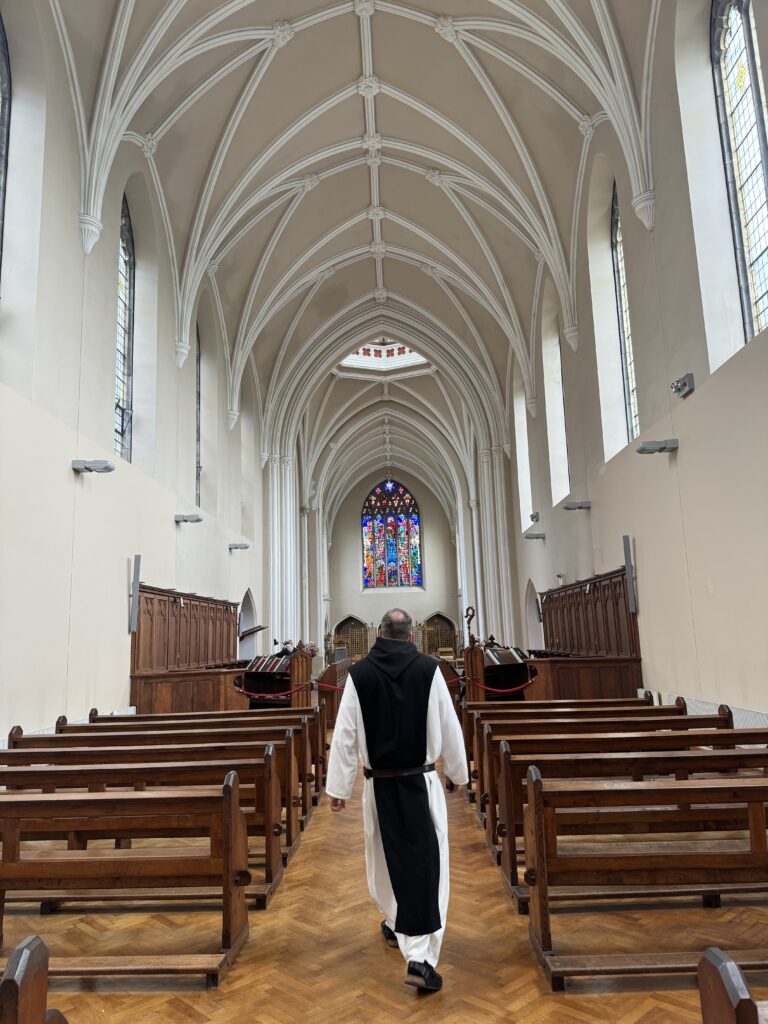
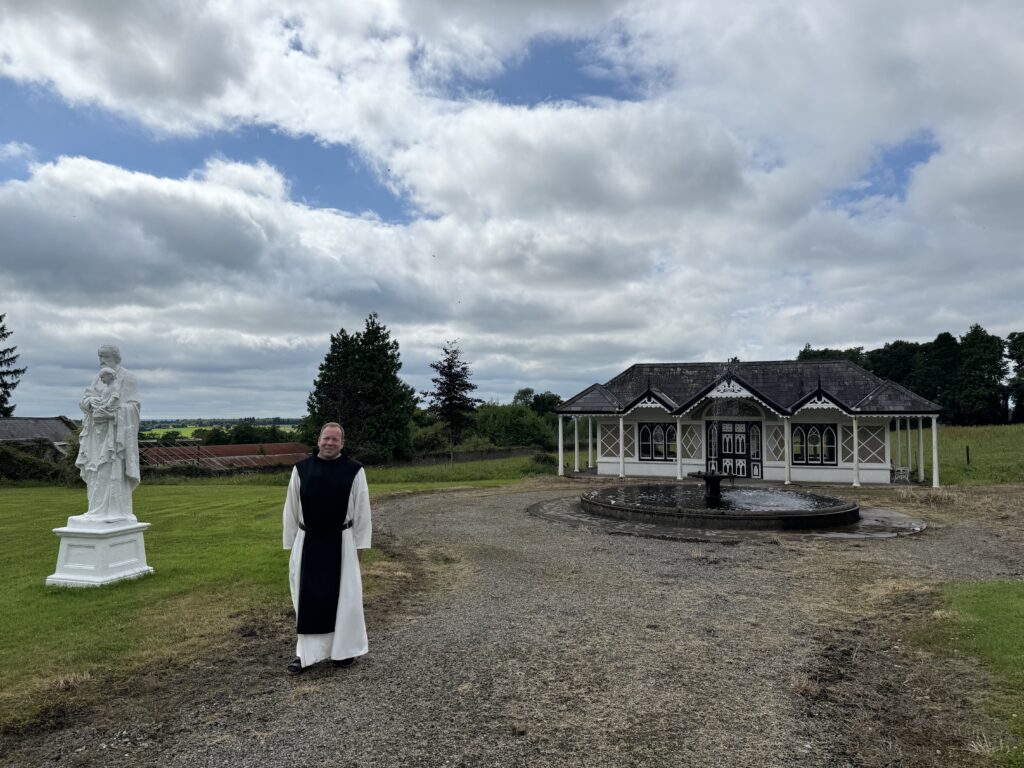
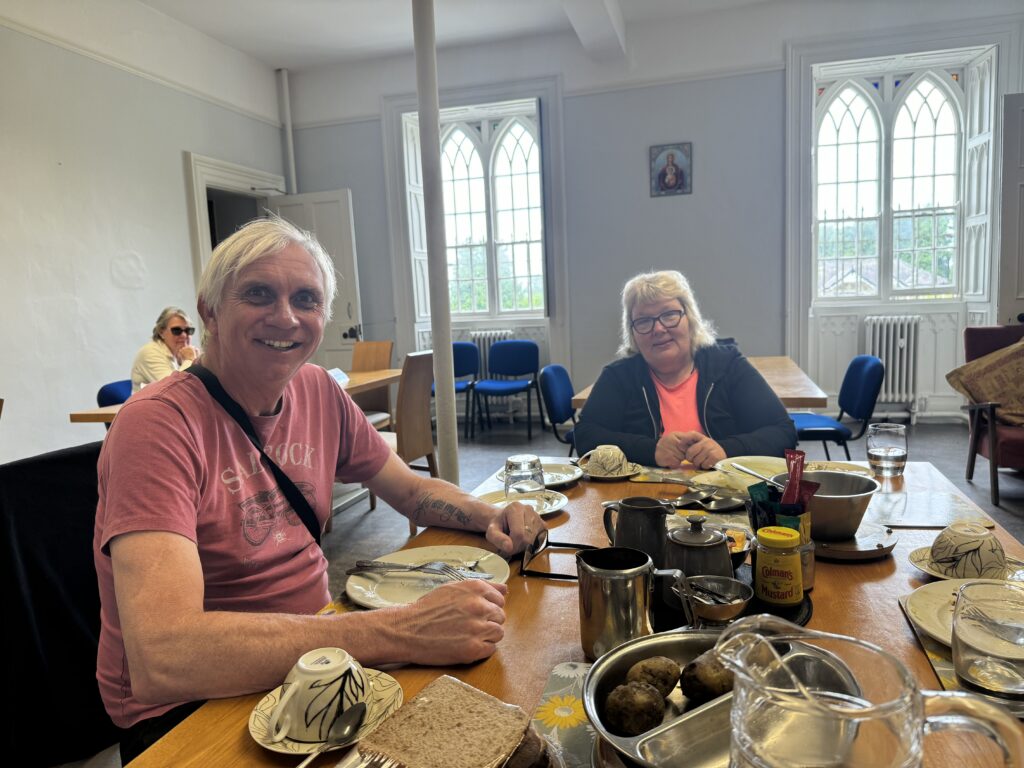
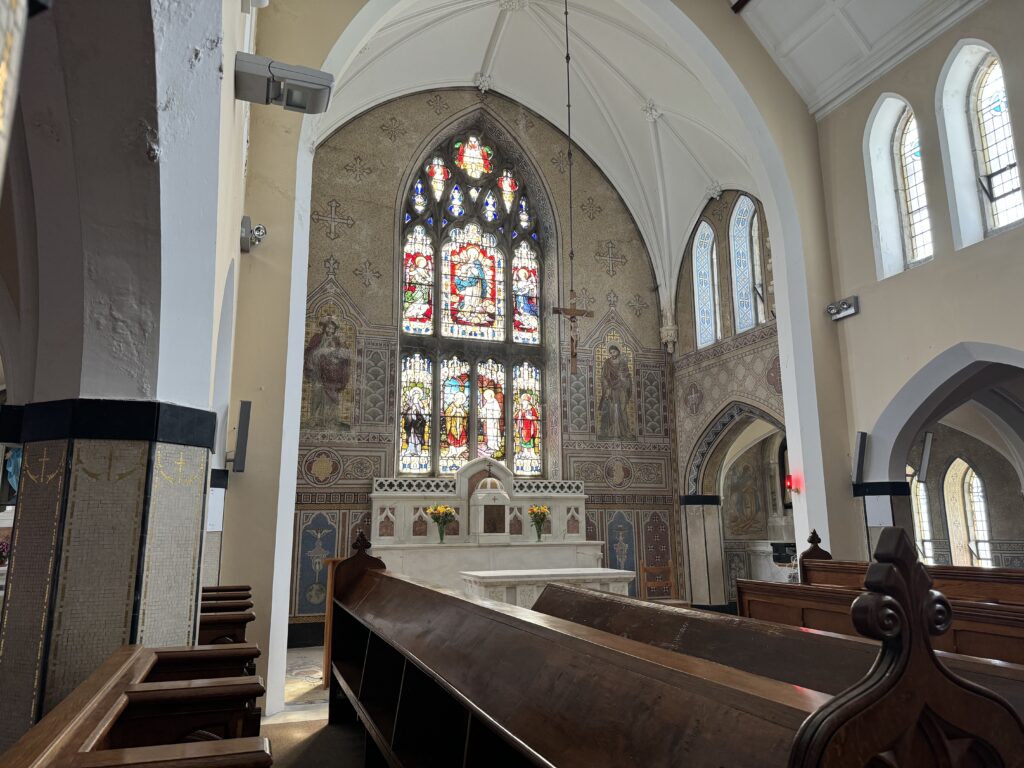


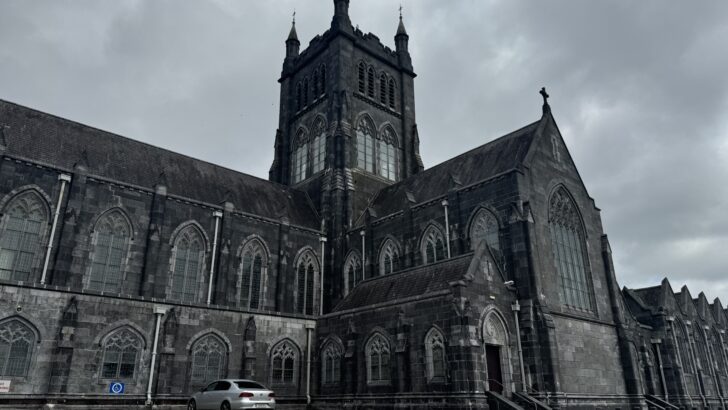 Mount Melleray Church’s
tower and nave
Mount Melleray Church’s
tower and nave